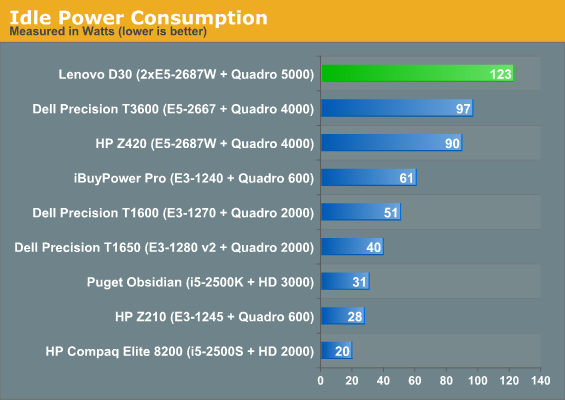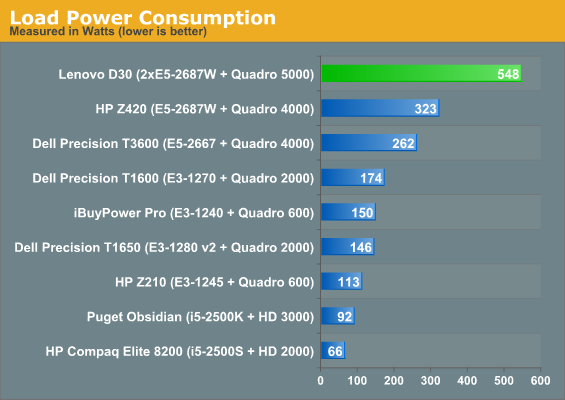Lenovo ThinkStation D30 Workstation Review: 16 Cores and 32 Threads Under Your Desk
by Dustin Sklavos on November 15, 2012 12:01 AM EST- Posted in
- Systems
- Lenovo
- Quadro
- Workstation
- Sandy Bridge E
- Enterprise
- Octalcore
Build Quality
Speaking candidly, Lenovo's internal design for the ThinkStation D30 may be at least somewhat competitive with HP's Z820's interior, but it's worlds behind Dell's Precision T7600. The design philosophy Dell rolled out with the T3600, T5600, and T7600 is probably the most thoughtful and detailed one I've seen in the workstations I've tested; Lenovo's interior in the D30 is comparably very staid and even a bit archaic in some respects.
.jpg)
For starters, the cable management is pretty poor for a system like this. For comparison's sake, below is the interior layout of the smaller Dell T3600. This isn't the most fair comparison since the D30 is a deeper case and has to support two processors, but I think the decisions involved in the design come across well enough.
.jpg)
Quite frankly, Dell's design is just cleaner. A lot of this owes to the modular power supply design they're using in their modern workstations; power supplies are designed to be easily removed and replaced out of the back of the case by the end user. Meanwhile, Lenovo's design still has a mess of cables spewing out of the back of the power supply. It's just sloppy, and worse, if the PSU goes, that's going to mean a tremendous amount of downtime.
Noise, Heat, and Power Consumption
Unfortunately HWMonitor flipped its lid trying to read the operating temperatures of the D30, but monitoring the system under load with AIDA64 revealed generally reasonable thermal performance. Noise was also for the most part a non-issue as it often is with these workstations, which is really impressive when you think about it. Lenovo was able to keep the noise level below the 30dB floor of my sound meter at idle, and then under load it peaked at a noticeable but still very tolerable 34.5dB from a foot away.
As for power consumption, it goes without saying that the D30 is going to be a bit of a monster. The combined rated wattage of the CPUs and GPU is 452W on its own, and that's ignoring the eight DIMMs and 15K-RPM mechanical hard drive.


It takes a lot of juice to sit at the top of the charts, but when you're pushing for as much raw performance as you can get (as you would with a system like this one), power consumption is really going to be a secondary concern.
.jpg)










68 Comments
View All Comments
theduckofdeath - Friday, November 16, 2012 - link
*rack mountedafkrotch - Wednesday, November 21, 2012 - link
It doesn't take a fanboy to see that Apple simply updates too slowly and that just isn't going to be an option where time is money.melgross - Thursday, November 15, 2012 - link
Very amusing. You must do standup.twtech - Thursday, November 15, 2012 - link
I would expect at least 32GB of RAM, preferably 64GB. There are other uses for a machine like that, but some compilers can use as much as 1.5GB per thread. With 16GB of RAM, you wouldn't even be able to use half the threads without hitting the swap file.Joschka77 - Thursday, November 15, 2012 - link
Thats exactly what i was thinking, too.Got an HP Z 820 with two E5 2680 and 128GB of RAM next to me...
This thing is a beast...
Rick83 - Thursday, November 15, 2012 - link
Got a z820 as well a few months ago, but IT's standard layout is 8x2 GB as well.ordererd 4x8GB to add - but the board doesn't support that as 48GB combination, so only running 32gigs.
Need moar memory.
Colleague is eyeing ordering another 32 to at least get the machine to be slightly more usable..
Joschka77 - Thursday, November 15, 2012 - link
As far as i know mixed RAM sizes should be possible; have you had a look at the Service manual for the Z820? There´s a hint in what order the Dimms should be placed. ->heres a link:
http://h20000.www2.hp.com/bizsupport/TechSupport/C...
afkrotch - Wednesday, November 21, 2012 - link
My last job I was running a Dell T7500. The more ram, the better. I didn't need as much processing power, but needed memory. Was using it for system integration work, so I was running multiple VMs. 16 gig of ram and I was running out all the time. Having to pause/shutdown a VM to fire up another one.duploxxx - Thursday, November 15, 2012 - link
If you want to really push the build quality and design, don't compare a 2 socket WS with 1 socket systems.You need to compare this system with a HP z620 and a Dell T5600.
If you really want to bring the added value over these way overprised CPU you need to find very specific applications to do so... for 99% they are never needed besides EGO. These days most will run just fine with a 1 socket WS with all the cpu power existing today.
extide - Thursday, November 15, 2012 - link
For the people who buy these systems, even dual E5-2687W's is still too slow.